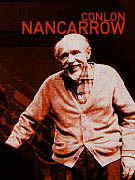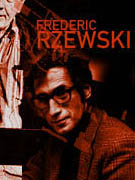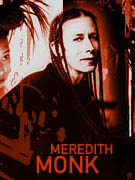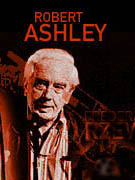 |
||
|
|
 |
|
| The Do-It-Yourself Composer |
|
Born in 1912, Conlon Nancarrow was the wayward son of the mayor of Texarkana, Arkansas. Like so many socially concerned Americans in the 1930s, he joined the Communist Party, which seemed at the time the party willing to do most for the working class. So committed was Nancarrow that in 1937 he ran off and fought against Franco with the Abraham Lincoln Brigade in the Spanish Civil War. Upon his return, he learned that Communist Party members were beginning to be hassled by the American government. So he moved to Mexico City, where he lived the rest of his life as a reclusive expatriate. Nancarrow wrote music. He was fascinated by complex rhythms, and he found that, in the 1930s, even the mildest rhythmic intricacies were beyond the reach of most performers. One clarinetist refused to play his music, because, he said, it made the audience think he was playing wrong notes. Nancarrow had a couple of disastrous performances, and then gave up - temporarily. In 1947, he inherited some money. He made a trip to New York. He had read in a book by composer Henry Cowell that one thing a player piano might be good for was playing complex rhythms. Having grown up with a player piano in his home, Nancarrow thought he might try that out. In New York Nancarrow bought a player piano - that was the easy part. The hard part was finding a machine that would enable him to punch player piano rolls. In those days, player piano rolls were made by pianists playing a machine that would leave ink marks on a roll as it went by, marking the paper according to where the pianist put his fingers. The roll would then be taken and the inked-over parts punched out by machine. But Nancarrow couldn't play the music he wanted to write; as a matter of fact, he couldn't play the piano at all. He needed to mark the holes himself, manually. He went to the QRS piano roll company, which was then in the Bronx and has since moved to Buffalo. There a mechanic showed him a small punching machine that was used for jobs too detailed to do on the big machines that did most of the rolls. Nancarrow copied the machine's specifications, and took them to an instrument maker in the Village who happened to have a machinist friend. The machinist told Nancarrow he'd make such a machine for $300. He built a custom-made punching machine. After it was finished, the machinist said, "I told you $300, but if I had to do it again I'd charge you I don't know what!" Years later, Nancarrow sent him another $500. Nancarrow was a big fan of the hot jazz pianists of the '30s, like Art Tatum and Earl "Fatha" Hines. He couldn't play the piano himself, but he had played a little jazz trumpet, and he knew how it was supposed to go. So in 1948 he sat down with his new punching machine and wrote a piece that sounded like three jazz pianists playing at once, with fingers like lightning. A few serious composers, like Igor Stravinsky and Paul Hindemith, had written modest pieces for player piano, but nothing like this. As the first person ever to truly explore the medium, Nancarrow learned that the player piano was capable of a lot more than just playing really fast jazz. It could play different tempos at the same time; racing, irregular glissandos with certain notes sustained; electrically fast alternations of chords involving the entire range of the keyboard. Through the 1950s, '60s, '70s, and '80s, Nancarrow lived in his house in Coyoacan, seeing very few people, and writing the most rhythmically complex music the world had ever known. Finally, in 1975 people started to notice. Peter Garland, a composer/musicologist living in Santa Fe, contacted Nancarrow and published some of his scores. Charles Amirkhanian recorded the player piano studies and released them on the 1750 Arch label. And during the 1980s, Nancarrow went from being barely an underground legend to being considered one of the most important composers of the 20th century. This story, of the composer whose music went unheard until he was in his 60s, is one of the strangest in the history of music. But Nancarrow may have been the first of a new breed. For the player piano also gave him something that composers had never had before, but now seek after: self-sufficiency. Nancarrow was the first composer to produce his music by himself, in seclusion, and to hear it performed perfectly, whenever he wanted, without performers, concert halls, or audiences. Next to architecture, music is the art that most requires a social support system. A painter can buy some canvas and paints and create a work of art without anyone else's help. A dancer needs only her body. A poet can get by with paper and a pencil. But the composer, except when he plays solo music on his own instrument, needs performers, and a hall to perform in. This is partly why music was slower to take off in 19th-century America than painting and literature were. Albert Bierstadt and Frederic Remington could take their paints out into the wilderness and capture a landscape that had never been painted before, and then exhibit the finished product. Composers, except for the occasional lucrative American tour under onerous conditions, tended to stay home in Europe, where the conductors, orchestras, concert halls, and audiences were. Even once America had established its own orchestras and music schools, they always seemed to give the lion's share of their support to European composers. In 1854, one American composer, George Bristow, quit his job as violinist in the New York Philharmonic to protest the orchestra's avoidance of American composers. (Imagine that happening today.) Still, early in the 20th century, certain conductors - notably Frederick Stock, who conducted the Chicago Symphony from 1905 until 1942 - would try to include one American work on most orchestra programs. However, even this modest support ended in the 1930s, as the U.S. was flooded with European refugees coming to escape the Nazis, including thousands of musicians, conductors, and even composers as prominent as Schönberg, Stravinsky, Bartok, and Hindemith. From the standpoint of American music, the pre-War deluge of European musicians was a disaster. The American composers who write in European traditions have always had more luck in getting performed within the classical music world than did America's maverick composers who formed their own styles. The maverick composers, like Conlon Nancarrow, wrote music that didn't conform to European expectations. They wanted more complex rhythms. They had jazz in the back of their heads. Sometimes they wanted a piece to sound different at every performance. They wanted unusual sounds, and requested unusual instruments. Sometimes they wanted the players arranged differently, with large separations between groups. The classical music world just couldn't handle it. One of the most persuasive impulses toward self-sufficiency came from John Cage. When Cage was young he visited the American 12-tone composer Adolph Weiss. Weiss, he recalled, had a large stack of scores on his piano of works that had never been performed. "He was somewhat embittered because of this," Cage remembered, "and I determined then and there that if I did get to the point of writing music I would consider my responsibility only half-finished if I didn't get it performed. I don't think of music as finished when it's simply written down." Cage imparted that attitude to generations of younger composers, who would perform their music themselves if necessary rather than have the score sit around neglected and silent. Someone once asked Cage what he thought was the lowest point in American culture. "1952," he replied. That also happened to be the year Cage had written his notorious silent piece, 4'33", perhaps the ultimate in composer self-sufficiency. When American music emerged again in the late 1950s, it did so through composers who had made themselves self-sufficient, or at least independent of a classical music world that no longer cared for them. There was Terry Riley, for instance. The son of a railroad man in the Sierra Nevada Mountains, Riley attended Berkeley and supported himself by playing ragtime piano in San Francisco's racy Gold Street Saloon. He was not only a pianist but a soprano saxophone virtuoso much influenced by the great jazzman John Coltrane. Riley was one of the first to use the then brand-new medium of electronic tape to turn himself into a one-man band. He would line up two or three tape recorders in a row, then run a roll of tape from the outtake reel of one through the recording and playback heads of the second, and into the take-up reel. Then he'd play his organ or saxophone, simultaneously recording and playing back as he did. Everything he'd play would be recorded by the first tape recorder, and then the tape would move along to the second recorder and play again after a second or two. It was the first tape delay. Using this system, Riley didn't need anyone else to jam with. In San Francisco, in New York, in Paris, he'd give concerts by himself that lasted all night. The 1960s were an explosion of do-it-yourself composers. Pauline Oliveros had also come from San Francisco, where she and Riley had experimented together with free improvisation, something that was then unheard of for classically trained musicians. Oliveros worked with tape delay too, using it to make noisy but meditative electronic works like I of IV, from 1965. Oliveros's bigger breakthrough, though, was inspired by the instrument she had grown up playing, the accordion - not your usual classical music vehicle. (However, in 1948 the University of Houston did take the instrument seriously enough to give her a bachelors degree in it.) In 1969, Oliveros began performing meditative improvisations with the accordion. She had studied T'ai Chi, Karate, and other Eastern meditation techniques based on breathing. The accordion, with its eternal squeezing back and forth, was the perfect musical metaphor for the slow, gradual human breath. More interested in the process of __ music than the product, Oliveros made pieces whose score was often no more than simple instructions. For instance, her 1975 piece "Horse Sings from Cloud" began with the instruction, "Sustain a tone or sound until any desire to change it disappears. Where there is no longer any desire to change the tone or sound, then change it." This was the beginning of a new genre: meditation music. |
||||||||||
|
Oliveros often performs solo, but groups can perform many of her works as well, and even by the audience, following her instructions. The purpose of her music is spiritual, and as she has said, "In this country, music is generally thought of as entertainment, not as a vehicle for social change or for the expansion of one's consciousness. Music is a very powerful medium, and it's mostly used manipulatively... to sell things and be sold itself... I feel it is important to make their own music." In the 19th century, composers were often virtuoso performers. This changed in the 20th century as everyone became more specialized, and a division of labor developed. But the 1960s saw a comeback for the solo composer/performer. In a few cases, this happened along traditional lines, as in the case of Frederic Rzewski. A powerful and dynamic pianist, Rzewski has written much of his music for piano, and his most famous works continue to be works he plays himself, such as his mammoth set of variations from 1975, "The People United Will Never Be Defeated." From the very beginning Rzewski believed in music as a conveyer of political messages, and "The People United" is based on a Chilean political song about uniting the workers of the world. For all its intended populism, Rzewski's hour-long work is a highly organized set of 36 variations, exploring a dazzling array of styles and techniques ranging from the unabashedly melodic to the abstract. Many other pianists have played the piece, but no one else matches Rzewski's propulsive forcefulness, nor his daring displays of improvisation. More common among maverick composers, however, is the nontraditional solo performer, such as Meredith Monk. Monk started out as a dancer and filmmaker as well as a composer and singer, to the extent that she is frequently reviewed by critics from all fields, who argue about which discipline she most belongs to. After a few extravagant early works - for example, her "Juice" from 1969 employed 85 Jew's-harp players spiralled down the ramps of the Guggenheim Museum - she retreated into solo work. Her training as dancer made her realize that the voice could be approached with the same range and flexibility as the body, and she began building a repertoire of vocal sounds and techniques, many of which she later found out were akin to those used in Balkan singing, Tibetan chanting, and other nonwestern vocal traditions. Monk's vocal techniques include glottal stops, warbly American-Indian-style vibrato, nasal singing, nonsense syllables, and many of the strange voice tones children use in games. Some pieces will contain only a word or two of text, such as "Oh, I'm scared" |
||||||||||
|
Starting in 1978, Monk formed her own ensemble and began writing for it. This was a common pattern. The maverick composers of the 1960s eventually came to feel limited by what they could perform by themselves, but they couldn't rely on the existing classical ensembles to be sympathetic to what they were trying to do. So, one after another, they formed their own groups, often enlisting sympathetic friends and even people who weren't especially trained musicians. Steve Reich had started out with a few pieces he could play himself or with one friend, like "Come Out" for tape loops or Clapping Music, for two people clapping. By 1970, however, his ambitions had grown, and he formed the ensemble Steve Reich and Musicians to play larger pieces like "Music for 18 Musicians" of 1976, still considered by some his greatest work. Philip Glass likewise formed the Philip Glass Ensemble to play huge, evening-length pieces like his "Music in Twelve Parts" of 1974. As time went on, other, younger composers followed this pattern. The ego trip of having a group named after yourself was not lost on them. Michael Gordon formed the Michael Gordon Philharmonic. Toby Twining formed a vocal ensemble called Toby Twining Music. Nick Didkovsky founded a jazz/rock/classical fusion band called Doctor Nerve, though the name refers to the group rather than one individual. In fact, the Reich/Glass ensemble concept truly revolutionized American music. Where conventional classical chamber music emphasized soloistic playing and individual virtuosity, Reich and Glass, writing music based on simple processes and working with musicians who were not necessarily virtuosos, introduced ensemble playing in which players doubled each other's lines, and were amplified by the use of synthesizers and microphones. This was no longer chamber music in the conventional sense, but a new kind of symphonic genre perfect for focusing new ideas to an audience in clear-cut lines. Amplification gave the composer-led new music ensemble the physical presence of a symphony orchestra, while preserving the composer's self-sufficiency and artistic control over his or her own work. And it was an awful lot more economical having six of your friends play your music rather than 70 highly paid, unionized musicians in tuxedos and formal gowns. For instance Nick Didkovsky is someone whose music combines jazz improvisation, rock drumming and energy, classical notation and form, and computer algorithms. He composes the music via computer, programming it to spin out streams of notes, and then shapes the results according to playability and taste. His music is so in-between genres, though, that there's no existing ensemble he could send it to. So he has his own hand-picked group of Manhattan musicians, playing wild pieces with computer-generated titles like "Take Your Ears as the Bones of Their Queen." Toby Twining is a singer, and has always been a composer of unusual vocal music. Like Meredith Monk, he calls for unusual vocal sounds, but more often he calls for extremely pure harmonies, like those found among Balkan folksingers and really serious barbershop quartets. Your average chorus would balk at the extensive microtonal notation in Twining's scores, which specify dozens of pitches per octave. But Twining's own ensemble, Toby Twining music, has learned to negotiate the far-out harmonies of his pieces like "Chrysalid Requiem." Often they perform by listening to a computer-generated tape of the true pitches, matching them as they sing. Of course, electronics have made many composers more self-sufficient. It is now common for composers to use computers to control banks of synthesizers, or even to store an orchestra of sounds on your laptop. Carl Stone, sitting by himself at a table, can move sliders and dials on his computer screen and make the thunderous sonorities of his piece "Nyala" rush around the room in 360-degree circles. As technology has progressed, the original tape delay effects that Terry Riley pioneered in the '60s have become available on more and more sophisticated digital units, often operated by foot. San Francisco composer and performance artist Pamela Z has developed an impressive variety of solo performance techniques, just standing in front of an audience with a number of foot controls and running her voice through the electronics. |
||||||||||
|
Even opera has become a self-sufficient, solo medium. In the 1970s, Robert Ashley began pioneering a new concept of opera based largely on spoken text. Beginning in 1978, he would sometimes perform scenes from his opera "Perfect Lives" by himself with a prerecorded tape in the background, or with his piano accompanist "Blue" Gene Tyranny. This wasn't opera as people were used to thinking of it, nor was it an opera that any conventional opera house would know what to do with. But Ashley had fused story-telling and music in a viable, economical genre that he could take on the road. Later, however, Rouse went beyond opera, and began making films on his home computer. He would write the music first, completely produce it in a computer software program like ProTools, then digitally film the scenes he wanted, and edit them together with the music on the computer. His first film produced this way was called "Funding" as a wry reference to what he made the film without. Of course, self-sufficiency is a smart survival strategy, but not an end in itself. What all of these composers yearn for is a network of musical institutions that will take an interest in the music, and produce it on a larger scale that doesn't leave all the responsibility on the composer's shoulders. The assumption, which doesn't always turn out to be true, is that if you get famous enough, this will happen. And it does. Composers like Michael Gordon who started out with their own ensembles have more recently ben commissioned to write for orchestra. Robert Ashley was commissioned by an opera company for his opera Balseros. Just as importantly, a number of maverick ensembles have grown up that take an interest in maverick music: such as Relache, the California E.A.R Unit, Essential Music, the Kronos Quartet. What would Conlon Nancarrow have thought of all of this? He lived until 1997, long enough to become well aware of the technological progress that had been made since the player piano. It had taken him sometimes as much as eight months to punch a player piano roll for a four-minute piece, and if he found he had miscalculated a tempo or put in some wrong notes, he would have to patch up the piano roll with Scotch tape, or occasionally repunch and entire roll. Towards the end of his life he knew that with computer technology the operations that took him months could have been reduced to a few days. But he felt he was too old to switch to a new technology, and besides, he had no regrets. He had spent 47 years in his studio in Mexico City, listening to his own unprecedented musical universe come to life, and he had never had to depend on anyone else to make it happen. By the time the world caught up with Conlon Nancarrow, he didin't need it anymore. Next time, we'll talk about a very different type of composer, the ones who don't care about self-sufficiency, as we explore the relation between that European behemoth the orchestra, and the composers who write for it.
|
||||||||||
 |
|||||
| American Mavericks | Archive | About | Contact | Stations | Features | Press | Listening Room | Discussion | Purchase | |||||






